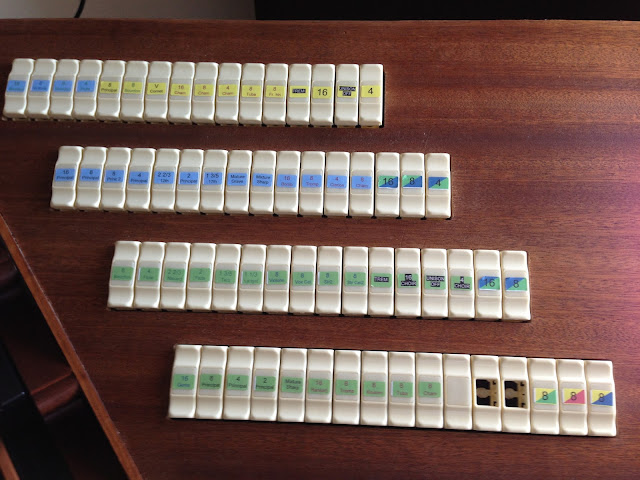The stop tabs are nice, Schlicker-style lighted stop tabs. Moving ones are always an order of magnitude more expensive, so lighted are a good compromise. The tabs are really nice in that one direction sends a different message than the other, so that ON is ON and OFF is OFF, and there is none of this toggle nonsense that is in most lighted stop tabs.
The construction of the bolsters was rather complicated. I wanted the angle to match the angle of rise of the keyboards, and sweep out from the console for easy access. This resulted in a complicated trigonometry problem I could never solve. So I just built it. It looks great now, but I know that there is a couple of degrees of error in a couple of places.
Here's the bolster partially assembled. It took two full days in the shop on a weekend to build them. I used left over wood - old walnut plywood cabinet doors. Ends up looking great, and no new wood to buy!
The completed bolsters with the stop tabs installed are here.
It took another week of evenings to build the cables, and a few evenings to debug them. Eventually, all was figured out. I was able to use ribbon cable for most of it, which really reduced the construction time of the cables. Only the ends that went into the controller were individual connection IDC connectors. This was good, in that I had to swap a few connections around when debugging.
The master controller in the lower left can control 128 stop tabs. There are 64 on each side, and I had to get the cables from one side to the other. I ran them under the table above the pedalboard so that the runs would be as short as possible. To hold them in place and cover them up, I hogged out a channel in a piece of oak moulding.
Note also the LED strip light. Gives great light for the pedals. I really need a structure for the music desk and keyboards. I could buy commercial like this, but I bought a bunch of high output LEDs for a previous project (LED garden lighting) which I might as well use. Of course, it will be a development effort... This will be in conjunction with building an oversized music desk as I had built for my old Johannus.
After debugging the wiring (with great instructions from Atilla at MidiWorks - big shout out) through the built in self test, there was the challenge of getting all of the tabs to light up. Another big shout out to Darryl at MidiWorks for his hints in configuring Hauptwerk. A couple of key things here. Firstly, you need to check the box that prevents Hauptwerk from checking for MIDI loops. Secondly, the pedalboard needs to be on a separate MIDI controller. For some reason, the toe studs which run through the pedalboard have a MIDI feedback which messes up the rest of the system. So on my system, I used my old M-audio UNO interface to receive only MIDI IN from the pedalboard. The rest of the system - 4 keyboards and the stop tab controller - go through the USB MIDI interface embedded in the keyboard.
So the (almost) completed system is here
Still left to debug are
1) Getting the lighted pistons to work. The pistons operate, but the lights don't work yet. The message is getting there, but either it's the wrong one, or it's not being properly operated on.
2) I had a display from midi-hardware.com (see the lower right of the left bolster) which I'm integrating. This display will be to show the current bank of memory in play, and the loading percentage of the instrument. This will be necessary to do any headless operation.
Still left to build is the large music desk with integrated desk and keyboard lighting.
For the stop layout, I borrowed a lot of ideas from Cameron Carpenter's Marshall & Ogletree design http://www.marshallandogletree.com/. Pedal is White, Swell is Red, Great is Blue, Positive is Green, and Solo is Yellow. Would be cool if I could get LEDs to match, but that's another project.
Within the color for the division, the color of the text indicates the type of stops. Black for Principals, Red for Reeds, Blue for Flutes and Green for Strings. Couplers would be solely color based. Because of having multiple Hauptwerk instruments, I chose to name the stops generically rather than by the specific pipe construction which would be specific to an instrument.
There's still some changes to be made. I used removable inkjet printable labels so that I can modify and change what doesn't work and improve the layout.
It's been a fun project. Anyone else want one?







No comments:
Post a Comment